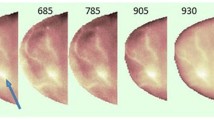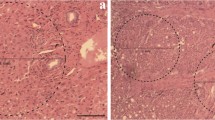Abstract
We report differences in the refractive index of healthy and tumorous freshly excised human breast tissue as determined from reflectance profile measurements at five wavelengths (432 nm, 532 nm, 633 nm, 964 nm, 1551 nm) in the visible and near-infrared using a standard prism-coupling refractometer. These refractive index differences, particularly in the near-infrared, can be used to distinguish fibroadenomas and cancerous growths not only from normal breast tissue but also from each other.





Similar content being viewed by others
References
Giannios P, et al. (2016) Visible to near-infrared refractive properties of freshly-excised human-liver tissues: Marking hepatic malignancies. Scientific Reports 6:27910 EP. https://doi.org/10.1038/srep27910
Giannios P et al (2017) Complex refractive index of normal and malignant human colorectal tissue in the visible and near-infrared. J Biophotonics 10(2):303–310. https://doi.org/10.1002/jbio.201600001
Tromberg BJ et al (2005) Imaging in breast cancer: Diffuse optics in breast cancer: detecting tumors in pre-menopausal women and monitoring neoadjuvant chemotherapy. Breast Cancer Res 7(6):279. https://doi.org/10.1186/bcr1358
Volynskaya ZI et al (2008) Diagnosing breast cancer using diffuse reflectance spectroscopy and intrinsic fluorescence spectroscopy. J Biomed Opt 13(2):1–9. https://doi.org/10.1117/1.2909672
Soares JS et al (2013) Diagnostic power of diffuse reflectance spectroscopy for targeted detection of breast lesions with microcalcifications. Proceedings of the National Academy of Sciences 110(2):471–476. https://doi.org/10.1073/pnas.1215473110, https://www.pnas.org/content/110/2/471
Colak SB et al (1999) Clinical optical tomography and NIR spectroscopy for breast cancer detection. IEEE Journal of Selected Topics in Quantum Electronics 5(4):1143–1158. https://doi.org/10.1109/2944.796341, https://ieeexplore.ieee.org/abstract/document/796341
Ashworth PC et al (2009) Terahertz pulsed spectroscopy of freshly excised human breast cancer. Opt Express 17(15):12444–12454. https://doi.org/10.1364/OE.17.012444, http://www.opticsexpress.org/abstract.cfm?URI=oe-17-15-12444
Dobbs JL et al (2013) Feasibility of confocal fluorescence microscopy for real-time evaluation of neoplasia in fresh human breast tissue. Journal of Biomedical Optics 18(10):1–11. https://doi.org/10.1117/1.JBO.18.10.106016
Abeytunge S et al (2017) Evaluation of breast tissue with confocal strip-mosaicking microscopy: a test approach emulating pathology-like examination. J Biomed Opt 22(3):1–11. https://doi.org/10.1117/1.JBO.22.3.034002
Sardar DK et al (2007) Optical properties of ocular tissues in the near infrared region. Lasers Med Sci 22:46–52. https://doi.org/10.1007/s10103-006-0421-y
Patterson MS, Wilson BC, Wyman DR (1991) The propagation of optical radiation in tissue. II: Optical properties of tissues and resulting fluence distributions. Lasers Med Sci 6:379–390. https://doi.org/10.1007/BF02042460
Calin MA, Parasca SV (2010) In vivo study of age-related changes in the optical properties of the skin. Lasers Med Sci 25:269–274. https://doi.org/10.1007/s10103-009-0725-9
Bosschaart N et al (2014) A literature review and novel theoretical approach on the optical properties of whole blood. Lasers Med Sci 29:453–479. https://doi.org/10.1007/s10103-013-1446-7
Wang Z, Popescu G, Tangella KV, Balla A (2011) Tissue refractive index as marker of disease. J Biomed Opt 16(11):1–8. https://doi.org/10.1117/1.3656732
Bolin FP, Preuss LE, Taylor RC, Ference RJ (1989) Refractive index of some mammalian tissues using a fiber optic cladding method. Appl Opt 28(12):2297–2303. https://doi.org/10.1364/AO.28.002297, http://ao.osa.org/abstract.cfm?URI=ao-28-12-2297
Ding H, Lu JQ, Wooden WA, Kragel PJ, Hu X-H (2006) Refractive indices of human skin tissues at eight wavelengths and estimated dispersion relations between 300 and 1600 nm. Phys Med Biol 51 (6):1479–1489. https://doi.org/10.1088/0031-9155/51/6/008
Jacques SL (2013) Optical properties of biological tissues: A review. Phys Med Biol 58(11):R37–R61. https://doi.org/10.1088/0031-9155/58/11/r37
Bashkatov AN, Genina EA, Kochubey VI, Tuchin VV (2005) Optical properties of human skin, subcutaneous and mucous tissues in the wavelength range from 400 to 2000 nm. J Phys D Appl Phys 38(15):2543–2555. https://doi.org/10.1088/0022-3727/38/15/004
Zhernovaya O, Sydoruk O, Tuchin V, Douplik A (2011) The refractive index of human hemoglobin in the visible range. Phys Med Biol 56(13):4013–4021. https://doi.org/10.1088/0031-9155/56/13/017
Zysk AM, Chaney EJ, Boppart SA (2006) Refractive index of carcinogen-induced rat mammary tumours. Phys Med Biol 51(9):2165–2177. https://doi.org/10.1088/0031-9155/51/9/003
Matiatou M et al (2021) Data on the refractive index of freshly-excised human tissues in the visible and near-infrared spectral range. Results in Physics 22:103833. https://doi.org/10.1016/j.rinp.2021.103833
Cassar Q et al (2018) Pilot study of freshly excised breast tissue response in the 300 – 600 GHz range. Biomed Opt Express 9(7):2930–2942. https://doi.org/10.1364/BOE.9.002930, http://www.osapublishing.org/boe/abstract.cfm?URI=boe-9-7-2930
El-Shenawee M, Vohra N, Bowman T, Bailey K (2019) Cancer detection in excised breast tumors using terahertz imaging and spectroscopy. Biomedical Spectroscopy and Imaging 8:1–9. https://doi.org/10.3233/BSI-190187
Vohra N, Bailey K, El-Shenawee M (2020) Terahertz experimental measurements of human breast tissue. 94th ARFTG Microwave Measurement Symposium (ARFTG), pp 1–4. https://doi.org/10.1109/ARFTG47584.2020.9071691, https://ieeexplore.ieee.org/document/9071691
Zysk AM, Marks DL, Liu DY, Boppart SA (2007) Needle-based reflection refractometry of scattering samples using coherence-gated detection. Opt Express 8:4787–4794. https://doi.org/10.1364/OE.15.004787, http://www.osapublishing.org/oe/abstract.cfm?
Zysk AM et al (2007) Needle-based refractive index measurement using low-coherence interferometry. Opt Lett 32:385–387. https://doi.org/10.1364/OL.32.000385
Zysk AM et al (2009) Clinical feasibility of microscopically-guided breast needle biopsy using a fiber-optic probe with computer-aided detection. Technology in Cancer Research & Treatment 8(5):315–321. https://doi.org/10.1177/153303460900800501
Sung H et al (2021) Global cancer statistics 2020: Globocan estimates of incidence and mortality worldwide for 36 cancers in 185 countries. CA Cancer J Clin 71(3):209–249. https://doi.org/10.3322/caac.21660
Waks AG, Winer EP (2019) Breast cancer treatment. A Review JAMA 321(3):288–300. https://doi.org/10.1001/jama.2018.19323
Schmitt JM, Kumar G (1996) Turbulent nature of refractive-index variations in biological tissue. Opt Lett 21(16):1310–1312. https://doi.org/10.1364/OL.21.001310, http://ol.osa.org/abstract.cfm?URI=ol-21-16-1310
Meeten G (1997) Refractive index errors in the critical-angle and the Brewster-angle methods applied to absorbing and heterogeneous materials. Meas Sci Technol 8(7):728. https://doi.org/10.1088/0957-0233/8/7/006
Jin YL, Chen JY, Xu L, Wang PN (2006) Refractive index measurement for biomaterial samples by total internal reflection. Phys Med Biol 51(20):N371–N379. https://doi.org/10.1088/0031-9155/51/20/n02
Koutsoumpos S, Giannios P, Stavrakas I, Moutzouris K (2020) The derivative method of critical-angle refractometry for attenuating media. J Opt 22(7):075601. https://doi.org/10.1088/2040-8986/ab8286
Li H, Xie S (1996) Measurement method of the refractive index of biotissue by total internal reflection. Appl Opt 35(10):1793–1795. https://doi.org/10.1364/AO.35.001793, http://ao.osa.org/abstract.cfm?URI=ao-35-10-1793
Author information
Authors and Affiliations
Corresponding author
Ethics declarations
For this study, IRB approval from the Administrative Board of the affiliated General Hospital and informed consent from all patients was obtained. All experiments were performed in compliance with the relevant laws and the institutional guidelines in accordance with the ethical standards of the Declaration of Helsinki.
Competing interests
The authors declare no competing interests.
Additional information
Publisher’s note
Springer Nature remains neutral with regard to jurisdictional claims in published maps and institutional affiliations.
Rights and permissions
About this article
Cite this article
Matiatou, M., Giannios, P., Koutsoumpos, S. et al. Complex refractive index of freshly excised human breast tissue as a marker of disease. Lasers Med Sci 37, 2597–2604 (2022). https://doi.org/10.1007/s10103-022-03524-0
Received:
Accepted:
Published:
Issue Date:
DOI: https://doi.org/10.1007/s10103-022-03524-0




